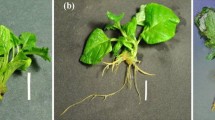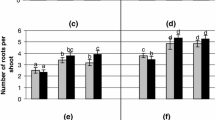Abstract
In vitro culture ofTanacetum parthenium (L.) Sch.Bip. was initiated from aseptically germinated seedlings. culture was derived from nodal explants of the seedlings on MS medium containing 4.44 μM (1.0 mg 1−1 ) 6-benzylaminopurine (BA) and 0.54 μM (0.1 mg 1−1) of α-naphthaleneacetic acid (NAA). Transformed roots were obtained by infection of the stems of aseptically grown seedlings withAgrobacterium rhizogenes LBA 9402. The parthenolide content in the cultivated plant organs was investigated by RP-HPLC. The production of the compound was strongly influenced by the genotype of the parent plant and ranged from 0.13% to 0.75% dry weight in the shoots of the rooted plantlets grownin vitro. The yield of the compound in multiple shoot cultures ofT.parthenium reached 60% of that found in the shoots of rooted plantlets. In contrast to shoots, only trace amounts of parthenolide could be detected in some clones of transformed roots and the roots of plantlets.
Similar content being viewed by others
Abbreviations
- BA:
-
6-benzylaminopurine
- DW:
-
dry weight
- FW:
-
fresh weight
- G.I.:
-
growth index
- NAA:
-
α-naphthaleneacetic acid
References
Anonymous (1985) Feverfew -anew drug or an old wives' remedy? (editorial) Lancet is 1084
Awang DVC, Dawson BA, Kindack DG, Crompton CW & Heptinstall S (1991) Parthenolide content of feverfew (Tanacetum parthenium) assessed by HPLC and1H-NMR spectroscopy. J. Nat. Prod. 54: 1516–1521
Banthorpe DV & Brown GD (1989) Two unexpected coumarin derivatives from tissue cultures of Compositae species. Phytochemistry 28: 3003–3007
Banthorpe DV & Brown GD (1993)Tanacetum parthenium L. Schultz Bip. (Feverfew):In vitro culture and prospects for the production of parthenolide. In: Bajaj YPS (ed), Biotechnology in Agriculture and Forestry, Vol 24 (pp 361–372). Springer Verlag, Berlin
Berry MI (1984) Feverfew faces the future. Pharm. J. 232: 611–614
Bohlmann F & Zdero C (1982) Sesquiterpene lactones and other constituents fromTanacetum parthenium. Phytochemistry 21: 2543–2549
Brown AMG, Lowe KC, Davey MR & Power JB (1996) Fever-few (Tanacetum parthenium L.): tissue culture and parthenolide synthesis. Plant Sci. 116: 223–232
Cappelletti EM, Caniato R & Appendino G (1986) Localization at the cytotoxic hydroperoxyeudesmanolides inArtemisia umbelliformis. Biochem. Syst. Ecol. 14: 183–190
Elhag HM, El-Domiaty MM, El-Feraly FS, Mossa JS & El-Olemy MM (1992) Selection and micropropagation of high artemisinin producing clones ofArtemisia annua L. Phytother. Res. 6: 20–24
Fulzele DP, Sipahimalani AT & Heble MR (1991) Tissue cultures ofArtemisia annua: Organogenesis and artemisinin production. Phytother. Res. 5: 149–153
Groenewegen WA & Heptinstall S (1990) A comparison of the effects of an extract of feverfew and parthenolide, a component of feverfew, on human platelet activityin vitro. J. Pharm. Pharmacol. 42: 553–557
Groenewegen WA, Knight DW & Heptinstall S (1986) Compounds extracted from feverfew that have anti-secretory activity contain an α-methylene butyrolactone unit. J. Pharm. Pharmacol. 38: 709–712
Gromek D, Kisiel W, Stojakowska A & Kohlmunzer S (1991) Attempts of chemical standardizing ofChrysanthemum parthenium as a prospective antimigraine drug. Pol. J. Pharmacol. Pharm. 43: 213–217
Heptinstall S, White A, Williamson L & Mitchell JRA (1985) Extracts of feverfew inhibit granule secretion in blood platelets and polymorphonuclear leucocytes. Lancet i: 1071–1073
Hooykaas PJJ, Klapwijk PM, Nuti MP, Schilperoort RA & Rorsch A (1977) Transfer of theAgrobacterium tumefaciens Ti plasmid to virulent Agrobacteria and to Rhizobium explanta. J. Gen. Microbiol. 98: 477–484
Johnson ES, Kadam NP, Hylands DM & Hylands PJ (1985) Efficacy of feverfew as prophylactic treatment of migraine. Brit. Med. J. 291: 569–573
Makheja AN, Bailey JM, (1981) The active principle in feverfew. Lancet i: 1054
Marles RJ, Kaminski J, Amason JT, Pazos-Sanou L, Heptinstall S, Fischer NH, Crompton CW, Kindack DG & Awang DVC (1992) A bioassay for inhibition of serotonin release from bovine platelets. J. Nat. Prod. 55: 1044–1056
Morgan AJ, Cox PN, Turner DA, Peel E, Davey MR, Gartland KMA & Mulligan BJ (1987) Transformation of tomato using an Ri plasmid vector. Plant Sci. 49: 37–49
Murashige T & Skoog F (1962) A revised medium for rapid growth and bioassays with tobacco tissue cultures. Physiol. Plant. 15: 473–497
Murphy JJ, Heptinstall S Mitchel JRA (1988) Randomised double-blind placebo-controlled trial of feverfew in migraine prevention. Lancet ii: 198–192
Paniego NB & Giulietti AM (1994) Artemisia annua L.: dedifferentiated and differentiated cultures. Plant Cell Tiss. Org. Cult. 36: 163–168
Pestchanker LJ, Giulietti AM, Pestchanker MJ, Guerreiro E & Giordano OS (1990) The sesquiterpene lactone dihydroleucodin in tissue culture fromArtemisia douglasiana. Phytochemistry 29: 1853–1854
Summer H, Salan U, Knight DW & Hoult JRS (1992) Inhibition of 5-lipoxygenase and cyclo-oxygenase in leucocytes by feverfew. Involvement of sesquiterpene lactones and other components. Biochem. Pharmacol. 43: 2313–2320
Woerdenbag HJ, Lûers JFJ, van Uden W, Pras N, Malingrd TM & Alfermann AW (1993) Production of the new antimalarial drug artemisinin in shoot cultures ofArtemisia annua L. Plant Cell Tiss. Org. Cult. 32: 247–257
Author information
Authors and Affiliations
Rights and permissions
About this article
Cite this article
Stojakowska, A., Kisiel, W. Production of parthenolide in organ cultures of feverfew. Plant Cell Tiss Organ Cult 47, 159–162 (1997). https://doi.org/10.1007/BF02318952
Received:
Accepted:
Issue Date:
DOI: https://doi.org/10.1007/BF02318952




